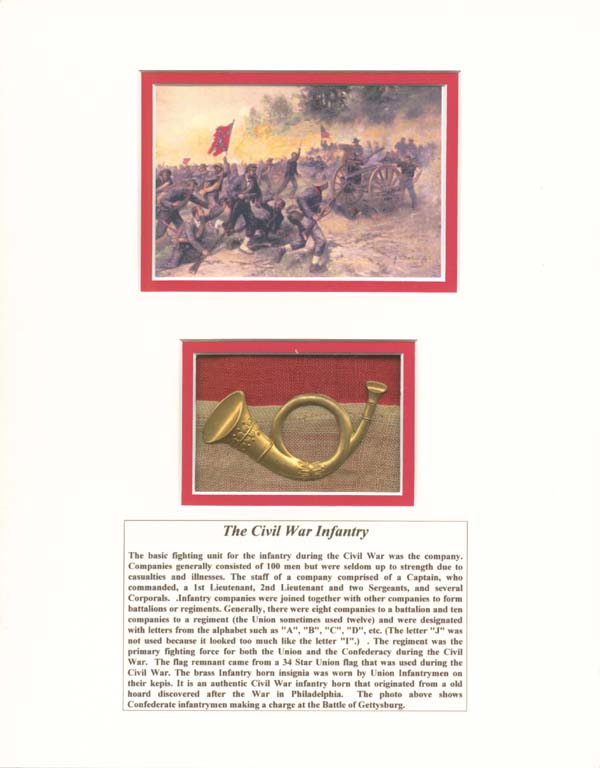1860's dated Flag Remnant and Horn Insignia From Civil War Relic
Inv# AM1168
The basic fighting unit for the infantry during the Civil War was the company. Companies generally consisted of 100 men but were seldom up to strength due to casualties and illnesses. The staff of a company comprised of a Captain, who commanded, a 1st Lieutenant, 2nd Lieutenant and two Sergeants, and several Corporals. Infantry companies were joined together with other companies to form battalions or regiments. Generally, there were eight companies to a battalion and ten companies to a regiment (the Union sometimes used twelve) and were designated with letters from the alphabet such a "A", "B", "C", "D", etc. (The letter "J" was not used because it looked too much like the letter "I".).
The regiment was the primary fighting force for both the Union and the Confederacy during the Civil War. This flag remnant came from a 34 Star Union flag that was used during the Civil War. The brass infantry horn insignia was worn by Union Infantrymen on their kepis. It is an authentic Civil War infantry horn that originated from an old board discovered after the War in Philadelphia. The photo shows Confederate infantrymen making a charge at the Battle of Gettysburg.
The 34 Star Flag was used from July 4, 1861 to July 3, 1863.
The flag of the United States, commonly known as the American flag or U.S. flag, serves as the national emblem of the country. It features thirteen equal horizontal stripes, alternating between red and white, with a blue rectangle in the upper left corner, known as the "union." This blue field contains fifty small, white, five-pointed stars, arranged in nine offset horizontal rows, alternating between rows of six and five stars. The fifty stars symbolize the fifty states of the United States, while the thirteen stripes represent the original thirteen British colonies that declared their independence from Great Britain, thus becoming the first states of the nation.
The flag is also referred to by several nicknames, including the Stars and Stripes, Old Glory, and the Star-Spangled Banner. Before the Civil War, the American flag was seldom displayed outside military installations, government offices, and naval vessels. During the American Revolutionary War and the War of 1812, the army was not officially permitted to carry the flag into combat. It was not until 1834 that artillery units were authorized to bear the American flag, with the army receiving similar permission in 1841. However, during the Mexican-American War in 1847, the flag was restricted to use within camps and was not allowed in battle. This situation changed dramatically after the events at Fort Sumter in 1861. The flag that had been hoisted over the fort was permitted to accompany Union troops as they surrendered. Its journey through northern cities ignited a fervor known as "Flagmania."
The stars and stripes, which had previously lacked significant public recognition, suddenly became integral to the national identity. The flag emerged as a powerful symbol of the Union, leading to a surge in flag sales. Consequently, the regulations from 1847 were rescinded, allowing the flag to be carried into battle. Although some advocated for the removal of the stars representing the seceded southern states, President Abraham Lincoln opposed this, believing it would confer legitimacy to the confederate states.










Ebay ID: labarre_galleries